A Ramble Through The Essence of Something-Or-Other

This page was originally put up to show a Norwegian lady mycologist of my (Usenet) acquaintance a small patch in the nicities of the hierarchy of trousers in this corner of England.
As time marches on, others in the trouser belt may very well (or may very well not, on the other hand leg) enter the fray - and not least in respect of the fray, the humble denim jeans in their fashionable distressed state could make an appearance on the fly, and no doubt as usual, I shall ramble off in many directions in an attempt not to bore the pants off you.
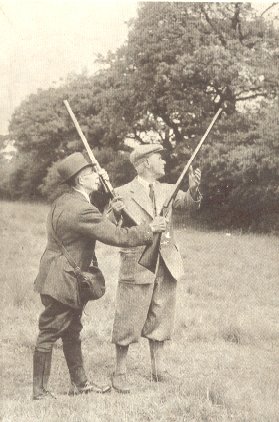 The picture on the right is from the dust-jacket of Shooting and Gunfitting by Arthur Hearn, and is included to illustrate the difference between knee-breeches and plus fours. The author of the book is on the left, and wearing knee-breeches. The 'Gun' wears the more 'toffy' plus fours, and is depicted passing his empty gun to his loader, while receiving the other of the pair which has been ready loaded for him. The style of the suits is of the mid 1940s, but in the intervening years has only changed slightly, in that the plus-four trousers tend to be slightly less roomy these days, and the lapels of the jacket are wider than today's fashion. You may not be surprised to learn that the type of hat the author is wearing is not favoured now, especially in the field, and you very seldom see the leather greaves either.
The picture on the right is from the dust-jacket of Shooting and Gunfitting by Arthur Hearn, and is included to illustrate the difference between knee-breeches and plus fours. The author of the book is on the left, and wearing knee-breeches. The 'Gun' wears the more 'toffy' plus fours, and is depicted passing his empty gun to his loader, while receiving the other of the pair which has been ready loaded for him. The style of the suits is of the mid 1940s, but in the intervening years has only changed slightly, in that the plus-four trousers tend to be slightly less roomy these days, and the lapels of the jacket are wider than today's fashion. You may not be surprised to learn that the type of hat the author is wearing is not favoured now, especially in the field, and you very seldom see the leather greaves either.
Plus fours were sported by the better-off, in the main. (For my part, I prefer a bathing costume in the main, but there's no fathoming the dictates of good taste.) Earls and bankers, golfers and the smart man-about-town would take to plus fours when in the country, and the less expensive and less expansive knee-breeches were more usually worn by country dwellers for several reasons: I will enumerate...
- Country dwellers, with the exception of some landowners, were generally not so well-off as your typical town beau;
- Country dwellers knew that even on a dry day in the countryside, the bottoms of plus fours very soon became wet and horrid, and in season, covered in burrs and cleavers;
- Country landowners often dressed their servants, gamekeepers, bailiffs, etc. in knee-breeches, and the Uppah Clesses would not have wished to be mistaken for such;
- Plus fours are funny.
Here, I'd like to fly off at a tangent and brag about my four-piece suit, which in 1947 was (bespoke) tailored in Kings Lynn from hand-wauked Harris Tweed. (to be Harris Tweed®, it must be hand-woven, but nowadays, it is machine-wauked, which process holds the warp and weft so that when the fibres shrink, the tweed loses no length or width. This strains the wool fibres and results in a much less hard-wearing product, but with a lighter, thinner feel to it, mainly because it is lighter and thinner.
For the pedants amongst us, 'wauked' may also be spelt as 'walked' and 'Waulked'.) The tweed of my suit is to the touch somewhat akin to Brussels carpet in its weight: indeed, I have often thought that a good living could be made in the carpet trade with the help of a Hattersley loom and a gang of wauking lasses.
Hand wauked means that the tweed was fulled (washed and shrunk) in the traditional manner by a gang of girls passing it through a long trough of water or other fluid, usually while singing one of the many Gaelic wauking songs as they did so.
My suit consists of jacket, waistcoat, trousers and plus fours, and is a rather striking ginger biscuit colour. This colour wouldn't exactly have been my first choice, but that was all the British Heart Foundation shop had in that line at the time.
Where was I? Oh yes, when I bought the book which initiated this bit of my pre(r)amble I was struck by the author's resemblence to Mr. Pastry, an early T.V. comedian, and wondered whether they might be related: but I had a little Google and found that Mr. Pastry's name was Hearne, not Hearn, so that was that lovely idea knocked on the head.
Well, after that introduction I'll get into something comfortable and show you round.
Ramble No.1
To set the stage, Bunwell is a small to medium sized village in South Norfolk. It consists of the village, often referred to as 'Bunwell Street', though properly, 'The Street' is the name of the road which runs through it. Included under the wing of Bunwell are the hamlets of Bunwell Hill, Bunwell Bottom and Bunwell Low Common, and it is rumoured that there is another called Bunwell cum Seek-Me, <Hoffnung> but I've never been able to find it. </Hoffnung>
Having started from trom The Village, I'm now rambling off in the direction of Bunwell Hill, but before I get there I'll stop off and have a mardle with the Head Keeper: you never know, I might get a cup of tea and an earful of squit, but the chances are I'll get caught for catching-up pheasant poults or something similarly hot and dusty.
Some pics:
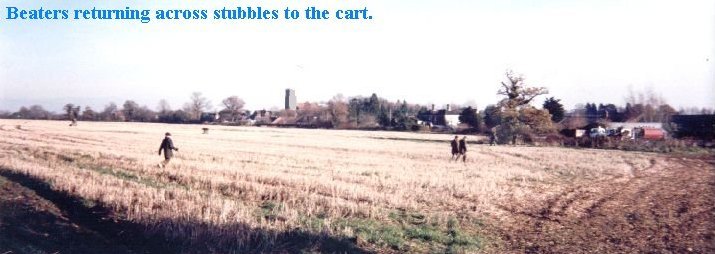
From the local shoot:
The pic below shows the beaters' wagon in the foreground,
with the Head Keeper, his Underkeeper and a gamekeeping
student from a local agricultural college, under training. Oh,
and we mustn't forget the Keeper's dog.
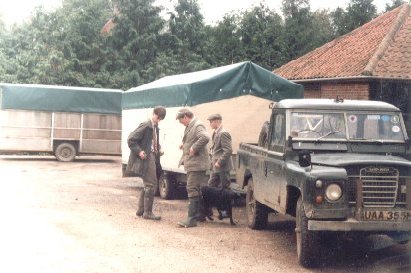
The Guns' wagon is in the background, and moving off up the
loke to their first drive of the day.

My job is sometimes that of the "bodysnatcher": that is, I collect the shot game from
the pickers-up, the beaters and the guns, depending on who has retrieved the birds.
These are hung from hooks to prevent the feathers from becoming bedraggled, and
to allow the birds to cool and to let the blood to settle in the body.
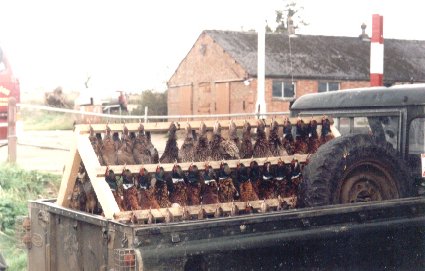
The Chariot of the Body-snatcher.
Ramble No.2
 There are truly breathtaking views waiting to be discovered in the unexplored interior of Norfolk. There is the giddying vista presented by the famous but little-known Tas Gorge, and the steep descent to the summit of Carleton Fen, however, one of Norfolk's most spectacular glories is the sky. Perhaps you didn't realise that the sky changes from county to county, and generally, in the UK, it joins pretty seamlessly. It is usually very difficult to see the join.
There are truly breathtaking views waiting to be discovered in the unexplored interior of Norfolk. There is the giddying vista presented by the famous but little-known Tas Gorge, and the steep descent to the summit of Carleton Fen, however, one of Norfolk's most spectacular glories is the sky. Perhaps you didn't realise that the sky changes from county to county, and generally, in the UK, it joins pretty seamlessly. It is usually very difficult to see the join.
Just think about the sky in France, though: it differs vastly from English, Scottish and Welsh skies, not just because it's French, but because it was painted by Picasso and Braque, which explains the sharp corners and lumpy shape of French clouds. I can't speak for Irish skies, which I have never had the good fortune to see, though in song, they seem to differ from our leaden English varieties for at least some of the time: (qv "When Irish Skies are Shining")
There is so much more sky in Norfolk than anywhere else except perhaps parts of Lincolnshire, and the Netherlands, where the land is even lower, and sometimes even below sea-level. This disposition allows for so much more sky because the horizon is correspondingly lower.
Now, Mt. Bunwell is the major tourist attraction that it is because of its imposing height, and because the horizon is so far beneath it, you can see further round the curvature of the Earth, resulting in one of the largest known skies in Europe, if not the world.
There is some fine horizontal climbing to be had over much of Norfolk, which is justly renowned for its stiff climbs. Mt. Bunwell however is in a class of its own, and is visited by experts in the field of plane abseiling and by anyone looking for the thrills of discovering new ways to traverse the stupendous top face or the technically difficult approaches to the summit.
Later, the exploits of Col. Carruthers, the noted bathchair climber.
Later still, descriptions of the annual gathering of the famous Over Eighties' Nudist Hang-Glider Association, based at Tibenham Airfield, and hereinafter referred to as the 'OENHGA'.
Tibenham was a USAF Liberator aerodrome during the war, and its commander was James Stewart. He is still remembered affectionately in the area.
Airfield page
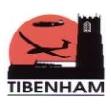

It is a measure of the sheer difficulty of the terrain that the Extreme Ironing people haven't even thought of attempting to practise their sport on Mt. Bunwell. I cordially invite them to make an attempt on the top face of the feature, and successfully to iron horizontally.

Tibenham village pages
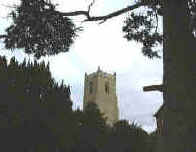
More when I get round to it.


 The picture on the right is from the dust-jacket of Shooting and Gunfitting by Arthur Hearn, and is included to illustrate the difference between knee-breeches and plus fours. The author of the book is on the left, and wearing knee-breeches. The 'Gun' wears the more 'toffy' plus fours, and is depicted passing his empty gun to his loader, while receiving the other of the pair which has been ready loaded for him. The style of the suits is of the mid 1940s, but in the intervening years has only changed slightly, in that the plus-four trousers tend to be slightly less roomy these days, and the lapels of the jacket are wider than today's fashion. You may not be surprised to learn that the type of hat the author is wearing is not favoured now, especially in the field, and you very seldom see the leather greaves either.
The picture on the right is from the dust-jacket of Shooting and Gunfitting by Arthur Hearn, and is included to illustrate the difference between knee-breeches and plus fours. The author of the book is on the left, and wearing knee-breeches. The 'Gun' wears the more 'toffy' plus fours, and is depicted passing his empty gun to his loader, while receiving the other of the pair which has been ready loaded for him. The style of the suits is of the mid 1940s, but in the intervening years has only changed slightly, in that the plus-four trousers tend to be slightly less roomy these days, and the lapels of the jacket are wider than today's fashion. You may not be surprised to learn that the type of hat the author is wearing is not favoured now, especially in the field, and you very seldom see the leather greaves either.



 There are truly breathtaking views waiting to be discovered in the unexplored interior of Norfolk. There is the giddying vista presented by the famous but little-known Tas Gorge, and the steep descent to the summit of Carleton Fen, however, one of Norfolk's most spectacular glories is the sky. Perhaps you didn't realise that the sky changes from county to county, and generally, in the UK, it joins pretty seamlessly. It is usually very difficult to see the join.
There are truly breathtaking views waiting to be discovered in the unexplored interior of Norfolk. There is the giddying vista presented by the famous but little-known Tas Gorge, and the steep descent to the summit of Carleton Fen, however, one of Norfolk's most spectacular glories is the sky. Perhaps you didn't realise that the sky changes from county to county, and generally, in the UK, it joins pretty seamlessly. It is usually very difficult to see the join.


